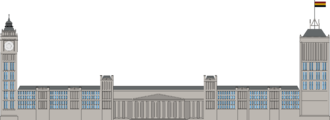Echegaray Palace: Difference between revisions
m (→Background) |
|||
| Line 31: | Line 31: | ||
==History== | ==History== | ||
=== Background === | ===Background=== | ||
Fortalesa da Aubanel, a large star fortress, had been located on the site since 1577, occupying a key strategic point in the defence of Madrigal. By 1868, however, it had fallen into complete disrepair, having been badly damaged by a magazine explosion during the Battle of Madrigal in 1826, resulting in the complete destruction of its north side. Material from the fortress had also been repurposed for other buildings, including the Imperial Palace and Echegaray Bridge. Considered an ideal site by | An immediate issue facing Marugán was finding a suitable location for the building. Fortalesa da Aubanel, a large star fortress, had been located on the site since 1577, occupying a key strategic point in the defence of Madrigal. By 1868, however, it had fallen into complete disrepair, having been badly damaged by a magazine explosion during the Battle of Madrigal in 1826, resulting in the complete destruction of its north side. Material from the fortress had also been repurposed for other buildings, including the Imperial Palace and Echegaray Bridge. Considered an ideal site by Marugán, the government gave its approval for its demolition, however popular discontent with the decision, and the protestations of the Imperial Preservation Society, which sought to protect monuments associated with Carloso's formation, forced a compromise to be reached. Rather than demolishing the fortress, it was decided to deconstruct and rebuild it in a different location, with each block being meticulously inventoried. It was ultimately rebuilt at a site 2.7 km (1.7 mi) west, with Aubanel Park being created around it. Damaged portions of the fortress were later repaired, becoming a major landmark of Madrigal in its own right. | ||
===Construction=== | ===Construction=== | ||
===Emergency War and restoration=== | ===Emergency War and restoration=== | ||
Revision as of 00:13, 21 August 2024
This article is incomplete because it is pending further input from participants, or it is a work-in-progress by one author. Please comment on this article's talk page to share your input, comments and questions. Note: To contribute to this article, you may need to seek help from the author(s) of this page. |
| Echegaray Palace | |
|---|---|
 Illustration of the east-facing side of Echegaray Palace. | |
| General information | |
| Type | Parliament |
| Architectural style | Neo-classical |
| Location | Madrigal, Carloso |
| Current tenants | National Assembly of Carloso |
| Construction started | 15 June 1868 |
| Completed | 9 November 1907 |
| Client | Government of Carloso |
| Height | 109.4 m |
| Design and construction | |
| Architect | Anton Dengra |
Echegaray Palace is a colossal administrative building in Madrigal, Carloso. It has served as the seat of the National Assembly of Carloso (and its predecessor, the Imperial Assembly) since 1907. Built in the neo-classical style, the huge structure had a prolonged period of construction, beginning on 15 June 1868 and not reaching completion until 9 November 1937. Prior to this, the much smaller Arcia Palace had served as the seat of the Imperial Assembly, however the significant increase of the number of representatives in the legislature, as well as the rapidly expanding bureaucracy of the newly formed Carlosian Empire necessitated the construction of a much larger complex. Since its completion, it has been regarded as a powerful symbol of Carloso's parliamentary democracy and of the power of the Carlosian state itself. Constructed mainly of cut limestone over a wrought iron frame, it survived repeated hits by Bourgougian bombs during the Emergency War with only superficial damage. On either end of the building are two prominent towers. Morón Tower, a four-sided clock tower, is itself a prominent landmark in Madrigal, its four smaller bells ringing every quarter hour, while its large bell rings every hour. On the opposite side of the building is Verdaguer Tower, topped with a flagstaff which bears a large Carlosian tricolour. It is by far the largest legislative building in all of Musgorocia, and one of the largest in the world.
Sitting in the Echegaray district of Madrigal (from which it takes its name), and on the banks of the Jefté, it is a major tourist attraction alongside nearby buildings such as the Assembly Libraries, the Madrigal Archives, Victoria Square, and Madrigal Cathedral. It is accessible via Echegaray metro station, located opposite the south side of the building. Throughout the year it is open to the public, and entry is free of charge. The National Assembly chamber is also open to the public when the legislature is not in session, with the exception of the visitors' gallery, which is accessible year-round.
History
Background
An immediate issue facing Marugán was finding a suitable location for the building. Fortalesa da Aubanel, a large star fortress, had been located on the site since 1577, occupying a key strategic point in the defence of Madrigal. By 1868, however, it had fallen into complete disrepair, having been badly damaged by a magazine explosion during the Battle of Madrigal in 1826, resulting in the complete destruction of its north side. Material from the fortress had also been repurposed for other buildings, including the Imperial Palace and Echegaray Bridge. Considered an ideal site by Marugán, the government gave its approval for its demolition, however popular discontent with the decision, and the protestations of the Imperial Preservation Society, which sought to protect monuments associated with Carloso's formation, forced a compromise to be reached. Rather than demolishing the fortress, it was decided to deconstruct and rebuild it in a different location, with each block being meticulously inventoried. It was ultimately rebuilt at a site 2.7 km (1.7 mi) west, with Aubanel Park being created around it. Damaged portions of the fortress were later repaired, becoming a major landmark of Madrigal in its own right.